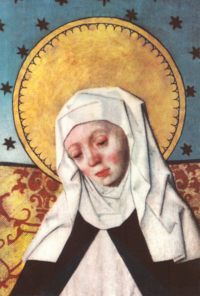Saint Bridget of Sweden
| Saint Bridget (Birgitta) of Sweden | |
|---|---|

Altarpiece in Salem church, Södermanland, Sweden (restored digitally)
|
|
| Widow | |
| Born | 1303 Uppland, Sweden |
| Died | 23 July 1373 Rome, Papal States |
| Venerated in |
Roman Catholic Church Lutheran Church |
| Canonized | 7 October 1391 by Pope Boniface IX |
| Major shrine | Vadstena Abbey |
| Feast | 23 July 8 October (Traditionalist Catholics) 7 October (Sweden) |
| Attributes | Pilgrim's hat, staff & bag; crown, writing-book. |
| Patronage | Europe, Sweden, Widows |
Bridget of Sweden (1303 – 23 July 1373); born as Birgitta Birgersdotter, also Birgitta of Vadstena, or Saint Birgitta (Swedish: den heliga Birgitta), was a mystic and saint, and founder of the Bridgettines nuns and monks after the death of her husband of twenty years. Outside of Sweden, she was also known as the Princess of Nericia and was the mother of Catherine of Vadstena. (Though normally named as Bridget of Sweden, she was not a member of Swedish royalty.)
She is one of the six patron saints of Europe, together with Benedict of Nursia, Saints Cyril and Methodius, Catherine of Siena and Edith Stein.
The most celebrated saint of Sweden was the daughter of the knight Birger Persson of the family of Finsta, governor and lawspeaker of Uppland, and one of the richest landowners of the country, and his wife, a member of the so-called Lawspeaker branch of the Folkunga family. Through her mother, Ingeborg, Birgitta was related to the Swedish kings of her era.
She was born in June 1303. There is no exact recording for which precise date. In 1316, at the age of 14 she married Ulf Gudmarsson of the family of Ulvåsa, Lord of Närke, to whom she bore eight children, four daughters and four sons. Six survived infancy, which was rare at that time. Her eldest daughter was Märta Ulfsdotter. Her second daughter is now honored as St. Catherine of Sweden. Her youngest daughter was Cecilia Ulvsdotter. Bridget became known for her works of charity, particularly toward Östergötland's unwed mothers and their children. When she was in her early thirties, she was summoned to be principal lady-in-waiting to the new Queen of Sweden, Blanche of Namur. In 1341 she and her husband went on pilgrimage to Santiago de Compostela.
...
Wikipedia
